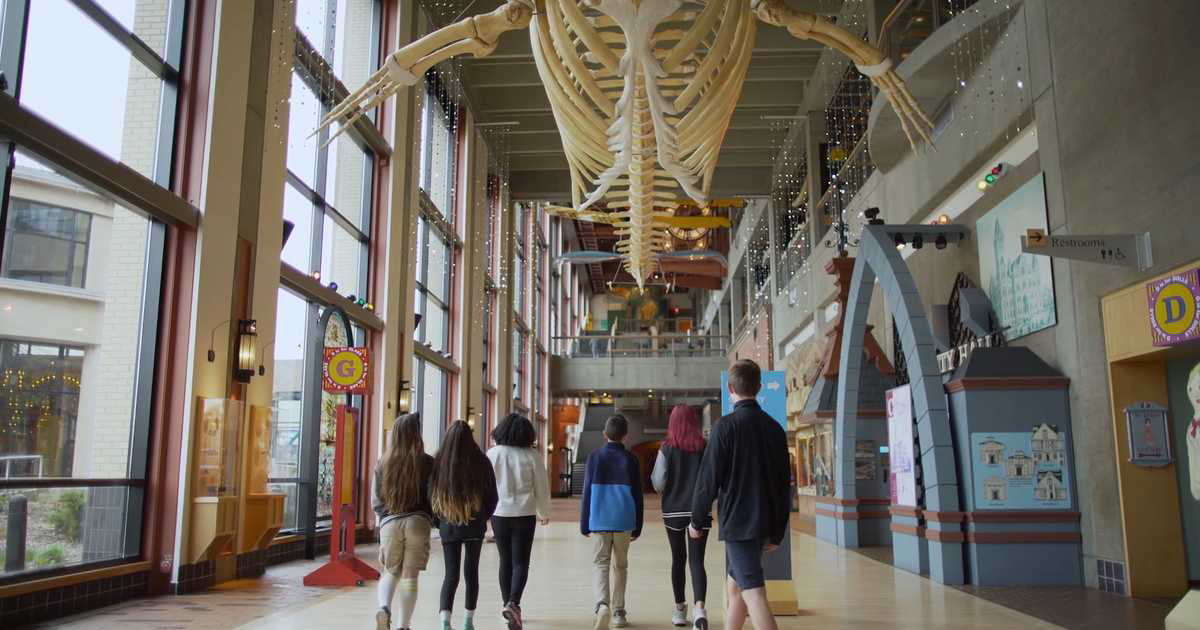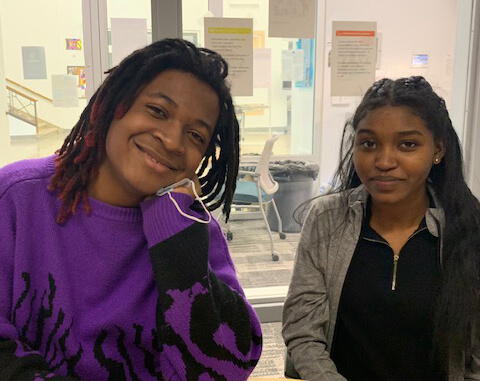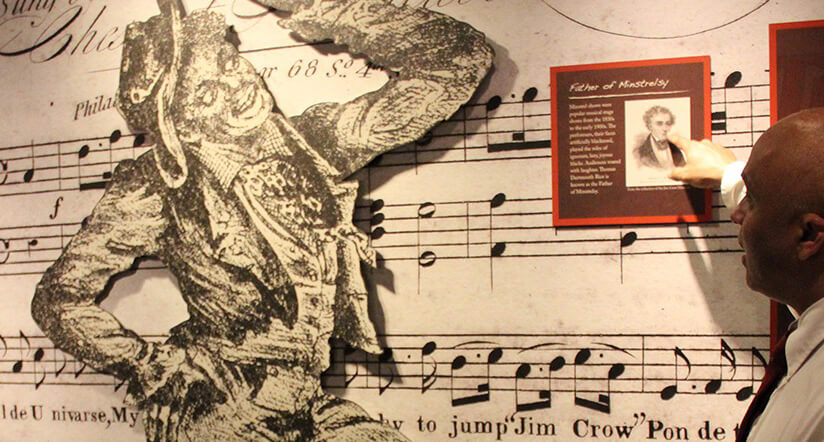This High School Uses Community Partnerships to Bring History to Life
At Grand Rapids Public Museum High School, an XQ school in Grand Rapids, Michigan, community…

At Grand Rapids Public Museum High School, an XQ school in Grand Rapids, Michigan, community partnerships are ingrained in the school’s mission and culture. These partnerships ignite students’ passions, offer glimpses into college and career options, accelerate learning, help students enhance their resumes, and build social capital.
For example, Attyn, a member of the GRPMS Class of 2024, always thought it was “normal” that his neighborhood in Grand Rapids wasn’t quite as safe and well-kept as other parts of town. He took it for granted that he felt welcome in some neighborhoods, and not others.
But then he took a course at his high school in partnership with a local nonprofit that opened his eyes to the forces that make Grand Rapids the dynamic city it is today. Attyn learned about the local history, and how the legacy of racist housing policies affected his own family’s story.
“This class made me realize how red-lining created these barriers in my neighborhood…Honestly, it was really shocking,” Attyn said. “As a Black person in America, learning these things is really helpful. And there’s so much yet to be unpacked.”
All XQ schools use partnerships as a way to bring learning to life, extending education beyond the walls of the classroom and into the community. In fact, well-planned community partnerships are a part of XQ’s Design Principles, guiding pillars for schools as they rethink how high schools can better prepare students for all the future has to offer.
In these partnerships, students can see, hear, and feel the relevance of their classroom lessons in the “real world.” By engaging with partners, students gain a better understanding of their communities, their cities, and the world beyond the local community.

The Power of an Authentic Audience
Community partnerships spark meaningful, engaged learning by connecting students’ classroom learning to real-world situations. Too often, high school lacks relevance to students’ lives outside of school. Through partnerships, students gain invaluable experience by working side-by-side with adults in the community and learning how their classroom lessons apply to the world beyond the campus boundaries.
GRPMS’s principal, Chris Hanks, explained how this experience supports students in “developing a sense of ownership and responsibility for their work.”
“To present their work to an authentic audience gives it credibility and meaning,” Hanks said. “That can be very powerful.”
GRPMS is designed to support strong partnerships relationships given that the school is built inside themuseum’s former home in downtown Grand Rapids. The school revitalized the old public museum building and has partnership with local businesses, community groups, government agencies, and two colleges. The myriad of resources at the museum allowed it to create a model of project-based and place-based learning for its diverse student body. The high school XQ helped to develop built off an existing middle school model located at the museum’s current location. Both are district schools.
Hanks said he feels fortunate that the Grand Rapids area has a plethora of community organizations that are willing to partner with schools. But he noted that all schools, no matter where they’re located, can create similar partnerships.
“We have a school in a museum, and I understand that not everyone has that opportunity,” he said. “But virtually every school has community institutions that are nearby and willing to collaborate. The opportunity is there for every school.”
Schools With Community Partnerships at the Center
Educators at all schools can take several steps to build strong partnerships that benefit both students and the community:
- Develop sustained relationships with partners
- Connect students with real-world experiences
- Align community interests with learning goals
- Connect projects to student interests and passions
Educators at GRPMS put these principles into action in the form of constant, ongoing community engagement. On any given day, students are working with the local merchant association to beautify the neighborhood, are helping museum staff to archive some of the museum’s 250,000 artifacts, or are working at local homeless shelters on art projects which focus on poverty and equity.
[
Principles in Practice: Start making change today with the XQ Design Principles rubric.
]
“These partnerships empower our students to be change-makers in their communities, no matter where they go,” said Hanks. “Our scholars bring their own expertise to these partnerships, but they’re also learning important things like collaboration, teamwork, and communication skills.”
One of the more dynamic partnerships at GRPMS is with The Diatribe, a local arts nonprofit for young people in the Grand Rapids area. The program provides curriculum and classes that blend both poetry and other forms of creative writing with social justice topics, such as fair housing and racial equity.
As part of the partnership, 10th graders from Grand Rapids take a nine-week course led by Diatribe artists, focusing on the history of housing inequality in Grand Rapids. They learn about red-lining—the practice of excluding certain groups such as Black people from certain neighborhoods—and its long-term negative impacts on residents, Grand Rapids’ communities, and the entire city as a whole.
Students tour various neighborhoods, explore the city’s gorgeous, dynamic murals, and learn about how discriminatory housing practices have shaped the way their city looks and feels. But the course is more than just lessons and field trips. Students discuss what they’re learning and grapple with their reactions by creating poetry, story-telling, and spoken word pieces. They finish by sharing their learning journeys with their classmates.
The partnership with The Diatribe fits closely with courses GRPMS students take that survey Black history, slavery, Reconstruction, the Great Migration, and the Civil Rights Movement, among other topics. The courses aim to blend history with social justice and English language arts in a way that makes the past feel relevant to students’ lives.
“These lessons they’re learning in the classroom are more tangible when scholars can connect these stories to the neighborhoods and cities they live in,” Hanks said. “It localizes the curriculum.”
Building 21st Century Learners Through Community Partnerships
Effective school community partnerships benefit both students and partners. These partnerships support rigorous learning as students address real challenges their community faces. To ensure partnerships achieve an effective level of rigor, educators can design projects around specific academic outcomes and competencies.
For example, courses such as those offered by The Diatribe dovetail with XQ Learner Outcomes. Original thinking, generous collaboration, foundational knowledge, and a lifelong love of learning—cornerstones of XQ’s learner philosophy—are all part of students’ experience in a well-planned school-community partnership.
These partnerships don’t just benefit students. By giving students an engaging, meaningful education experience, partners create a positive feedback loop in their community. Helping to educate the next generation of leaders and citizens about the value of community engagement, and giving back, enriches a city’s culture and sustainability.
Students can provide another important asset to partners with a fresh perspective on old problems. The energy, creativity, compassion, and enthusiasm from young adults can shed new light on complex issues—such as homelessness or inequality—that have bedeviled previous generations. Partnerships can help students jumpstart problem-solving for the 21st century.
Raising Awareness and Opening Doors
Adaga, a GRPMS class of 2024 student, shared how she found The Diatribe class relevant. She said it opened her eyes to the urban history of Grand Rapids and its spatial development. In her presentation, she focused on how unfair housing practices continue to impact women today.
She and her classmates created a plan to help find homes for women in Grand Rapids experiencing homelessness. The project raised her awareness of how low-income women continue to struggle for basic needs such as housing and inspired her to take action to help women in her community.
“It was sad. There are women who struggle with finding a place to stay,” Adaga said.
Poetry in Motion
Her classmate Attyn said the project shed light on the city his family has lived in for generations. Originally from Mississippi, his relatives were part of the Great Migration to northern cities like Grand Rapids in search of better opportunities.
But Grand Rapids, like many other cities, had housing policies that limited where Black families could live. Even now, decades after the federal and state governments overturned those policies, Attyn said he felt like the legacy of racism still affects him and his family.
Writing poetry and stories with teachers from The Diatribe helped him understand his feelings and make sense of the world he lives in. These projects also allowed him to hone his literary and creative skills, tapping into a passion for self-expression. Although he’s not sure yet what career he’ll choose, he now knows it will include writing and social justice.
“Writing gives you a way to process what you’re learning, make connections, think things through,” Attyn said.

Turning Racist Memorabilia into Hands-On Learning
Community partnerships can enhance almost any academic subject. For the next outside-the-classroom endeavor, GRPMS planned a partnership with the Jim Crow Museum of Racist Memorabilia at Ferris State University in Big Rapids, Michigan. Building on their experience at the museum that shares their campus, GRPMS Class of 2023 students will help archive and create a curriculum based on the Jim Crow museum’s largest-in-the-nation collection of racist artifacts.
The project dovetails with a class called Society and Self, which blends civics and English language arts. As students sharpen their literacy skills, they’ll expand on their archiving of knowledge, and gain a deeper understanding of the racism that was once pervasive in American culture.
In addition, students will tour the 935-acre campus, learning about the myriad career and educational pathways available just an hour north of Grand Rapids.
XQ encourages all schools to partner with local nonprofits, government agencies, arts groups, businesses, universities, and other organizations that can bring a new dimension to classroom learning and ultimately change students’ lives.
Expanding school beyond the four walls of the classroom makes academic lessons come alive, and can help launch students on trajectories they never dreamed of. A good school-community partnership shows that learning can happen anywhere.









